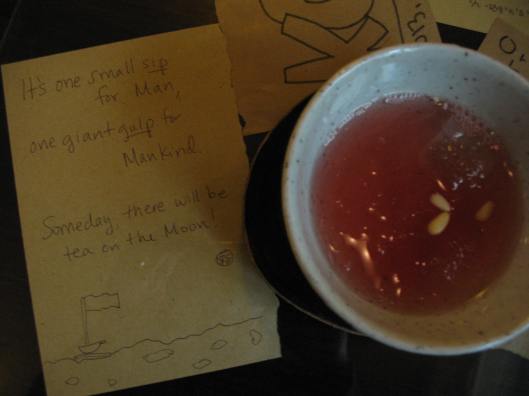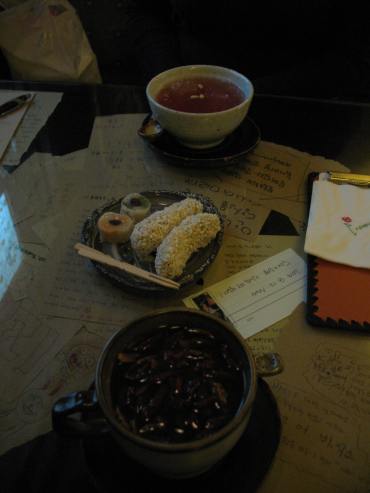Tags
For Tea Tuesday this week, I wanted to share my trip to a traditional Korean tea shop in Insadong, Seoul. Insadong is the “old town” area of Seoul city where the disorienting, windy streets treat the pedestrian to countless restaurants, tea houses, and souvenir shops. After a tasty lunch, we chose a tea shop at random, and I was delighted with our discovery.
We climbed the creaky wooden stairs to a warm upper room with a wooden interior.
As we were lead towards our cozy, cushioned booth in the back of the narrow room, we noticed that the walls were covered with sheets of paper.
Under the glass cover on our table were more of these hand-written sheets, notes and messages left by years of visitors from all over the world written in every language. On our table was a blank notebook and a pencil for us to write our own message to future tea-drinkers.
The menu was large – there were probably two dozen different teas to choose from. After much discussion and some advice from our server, my husband and I settled on two traditional Korean teas. Mine was called Omijacha or “Five Taste Tea.” This tea is served cold and sweet and is a beautiful pink color. It is made from the dried fruit of the schisandra chinensis vine, and it is supposed to have five tastes, sour, bitter, sweet, spicy, and salty. I think I only tasted sweet and sour, but I found it to be very good. My husband’s Jujube tea was served hot and had the strangest woody, savory-sweet flavor – I can’t describe it, but it was unlike anything I had tasted before. Both teas were served with sweet rice snacks.
While enjoying our tea, we came up with our own note to leave behind.
 I wish we had more time in Seoul to further explore Korean tea culture; there are so many unique Korean teas we did not have a chance to try. For more info, check out this Korean Tourism site.
I wish we had more time in Seoul to further explore Korean tea culture; there are so many unique Korean teas we did not have a chance to try. For more info, check out this Korean Tourism site.





I believe ‘five taste’ is a wrong translation. Omija is the name of a berry and cha means tea. Omija somehow have chinese characters which could be translated as five taste, but basically it is ridiculous…(a Korean passing by)